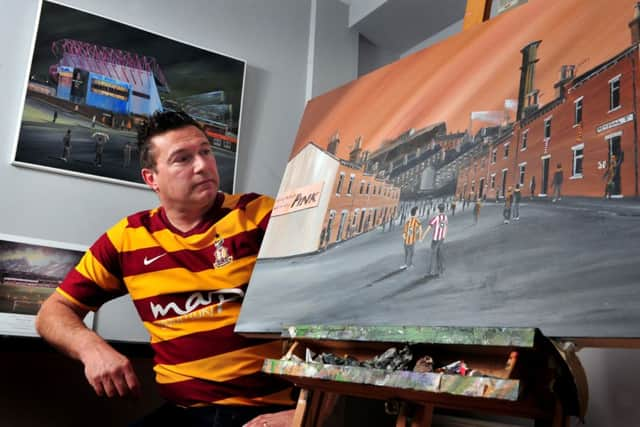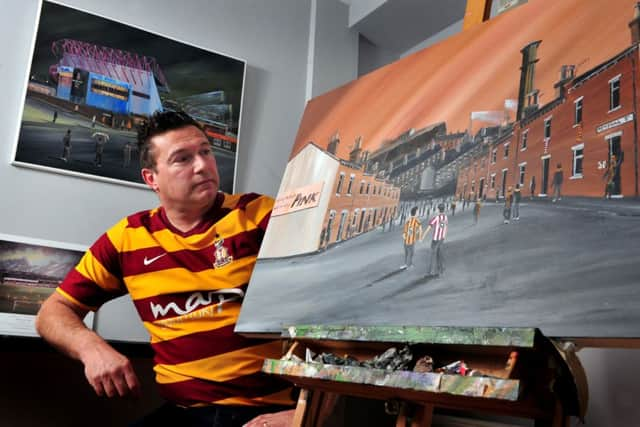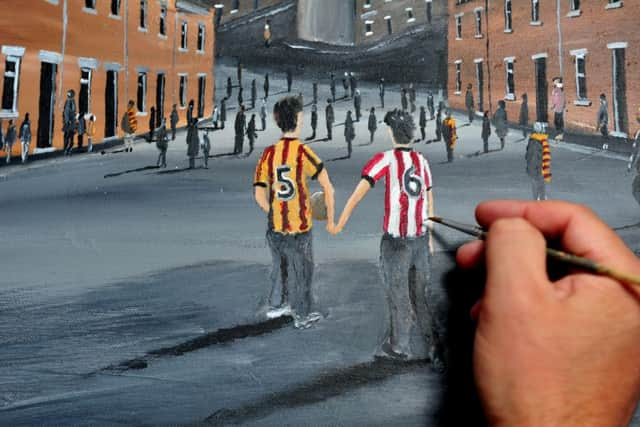30 years on, memories of Bradford’s darkest day


HE remembers it vividly, as if it happened yesterday. The screaming. The flames. The victims.
For 30 years those scenes have stayed etched in Paul Town’s mind. But slowly, helped by an unlikely healing process, he has discovered a way through the trauma. And he is putting his newly found skills to good use, by helping those whose suffering was even greater than his.
Advertisement
Hide AdAdvertisement
Hide AdPaul used to enjoy drawing when he was a child and two years ago his mother suggested he try his hand at painting, to see if that could help stop the flashbacks to the time when 56 people were killed as fire turned a celebratory afternoon at the football into a day of devastation.


Paul was only 15 on May 11, 1985. He had been a devoted Bradford City fan from the age of nine. Each matchday, he would go with his dad and each time the excitement would build as they approached Valley Parade.
On May 11, there was even more reason to be excited. Bradford had won the Third Division title, and would be parading the trophy in front of the fans at the last game of the season, against Lincoln City. “The sight of the floodlights among the mass of mills, chimneys and terraced houses was enough for me. It was Saturday - match day - but this was like no other, my club had achieved something special,” says Paul.
He followed the usual pre match routine. His dad parked the car and they walked up Midland Road, popped into the club shop to look at the souvenirs, then bought a programme outside the dressing room entrance, before handing over their season ticket stubs and entering the dark confines of the old wooden stand. A stand that was due to be demolished a few days later.
Advertisement
Hide AdAdvertisement
Hide Ad“At the back of the stand was a dark corridor with narrow turnstile entrances at the rear. Along this corridor were the entrances to the top tiers of seating. More a wooden plank with timber floorboards underfoot. Below these floorboards lay decades of accumulated rubbish.”


Along the corridor were two tea bars. “Those lovely ladies who worked inside these dimly lit confined spaces always had a smile when we saw them. They reminded me of my great grandma, such warmth and love serving drinks and pies on a Saturday afternoon. They didn’t have to do this but you could tell they loved it. This was their football club.
“Helping in the tea bar was a younger looking, almost stunning, blonde girl. I was too shy to give her a smile most weekends but I will never forget her smile. Unfortunately I never saw her again.” Bovril and programme in hand, Paul walked with his dad to their seats in the middle of the stand. As usual, a few minutes before half time, Paul’s dad went back to the tea bar to get a coffee and a Mars bar.
What happened next changed Paul’s life forever. A lighted match or cigarette end had been dropped to the floor at the back of the stand. It sparked a blaze which spread with bewildering speed and such intensity that the bodies of two of the victims were found sitting in their seats. The first Paul knew was when someone shouted: “There’s a fire at the Kop end.”
Advertisement
Hide AdAdvertisement
Hide Ad“At first I didn’t take much notice, although a few seconds later as I looked left I could see huge flames rising from the seats,” he says. “The flames were coming along the timber roof. A ball of fire with almost a look of evil within it. I can still hear the sound of it. I wish this sound would go away but I appreciate, along with others, it’s with me for life.”
As he struggled to take in the scene, his dad suddenly appeared behind him. He shepherded him down the stand towards the pitch and shouted at him to get out as fast as he could. “I ran with all the energy I had. It was like one of those nightmares where you can’t run and you keep falling over. Thing is, this was a real nightmare. This was happening.
“Once I had reached safety I turned around to see something you should never see at a football match.” In front of him, the entire stand was ablaze. One poor man staggered onto the pitch completely engulfed in flames. Fans managed to smother him to put the fire out, but he sadly died a few days later.
“I couldn’t take in what was happening in front of me. People who were so badly injured lay in the goalmouth being treated and comforted by the ambulance crews, players and fans alike.”
Advertisement
Hide AdAdvertisement
Hide AdHe began the long walk home, unsure what had happened to his dad who had returned to the stand to help people. He was given a lift when one of his dad’s mates saw him and within minutes of arriving home, his father pulled up outside in his car. He had made it out safe. They were among the lucky ones.
Over the next few hours, and days the casualty list grew, ending with 56 dead and 265 injured. Those who lost their lives included the girl from the tea stand.
The horror of that day has stayed with those who were there. “The scars are not visible. Like many other people, they are embedded within,” says Paul. On the Monday after the fire he went back to school. At the end of that day he left never to return. He went on to become a builder but remained haunted by what he had witnessed.
Then at Christmas two years ago he received a painting kit from his mum, who herself used to be an artist, and he began doing pictures of football grounds. Word started to spread and orders began to pour in from around the country.
Advertisement
Hide AdAdvertisement
Hide AdPaul, now living in Baildon, is finding an outlet for a talent he never knew he had. But one picture wasn’t ordered. It was one he felt he had to paint. Broken Souls is a powerful image, featuring two fans, one in a Bradford kit, the other in the colours of Lincoln City, holding hands. Dotted around the landscape are 54 other figures.
Paul is selling 56 prints of the picture at the symbolic price of £56, with all the money raised going to the Bradford Burns Unit. A bid of £350 has been made for the original, and Paul is confident of reaching his target of £3,000.
“What happened that day has stayed with people. It’s not something you talk about, and perhaps that has been part of the problem. With disasters like Hillsborough there has always been that search for answers, to find out exactly what happened, and that may have helped people in a way. With the fire it was obvious what happened, and people who were there just got on with things afterwards.”
He says all the pictures he paints are in memory of the 56 people who died. “The memorial picture is painted from my mind’s eye. The landscape you see is of a northern town gripped in grief.
Advertisement
Hide AdAdvertisement
Hide Ad“Painting this has eased some pain and anxiety personally, but I didn’t do it for this. I did it to help others and help raise funds for people who are less fortunate.”
• To see Paul’s pictures, including one in memory of the two Lincoln City fans who died in the fire, go to www.stadiumportraits.com
BRADFORD’S DAY OF TRAGEDY
The subsequent inquiry into the disaster led by Mr Justice Popplewell established that the fire had been started by either a discarded cigarette, or a match that had fallen between one of the many gaps in the wooden floorboard.
Once the smoke had turned into fire the whole of the Valley Parade main stand was quickly engulfed. With the exit gates locked and the turnstiles only able to be operated from outside the ground on South Parade, there was simply no escape amid the searing heat.
Advertisement
Hide AdAdvertisement
Hide AdOf the 56 who ultimately died, 19 bodies were found by one turnstile and 22 next to another. Three more were found in the toilet.
As well as those who lost their lives, a further 265 fans were injured.